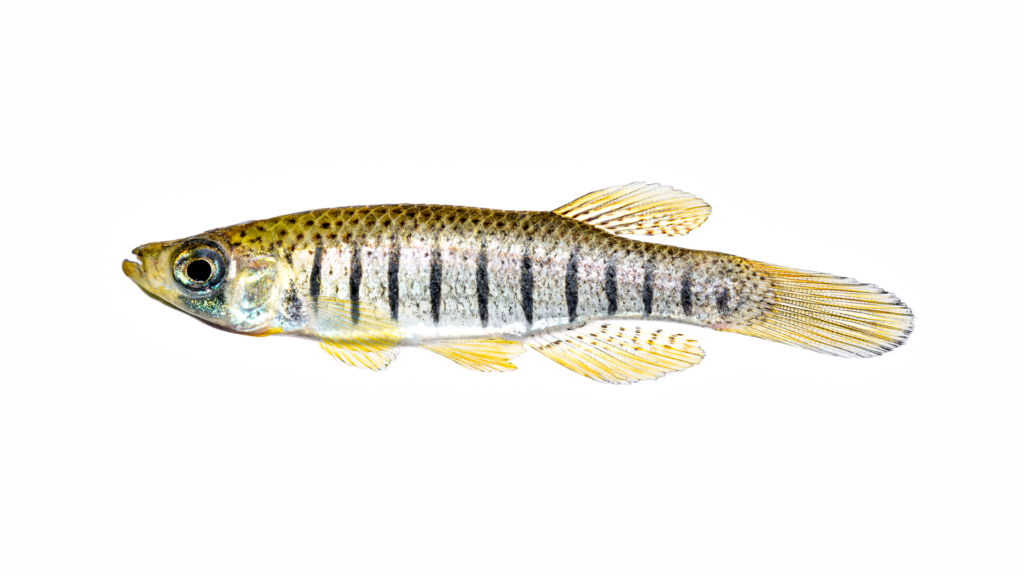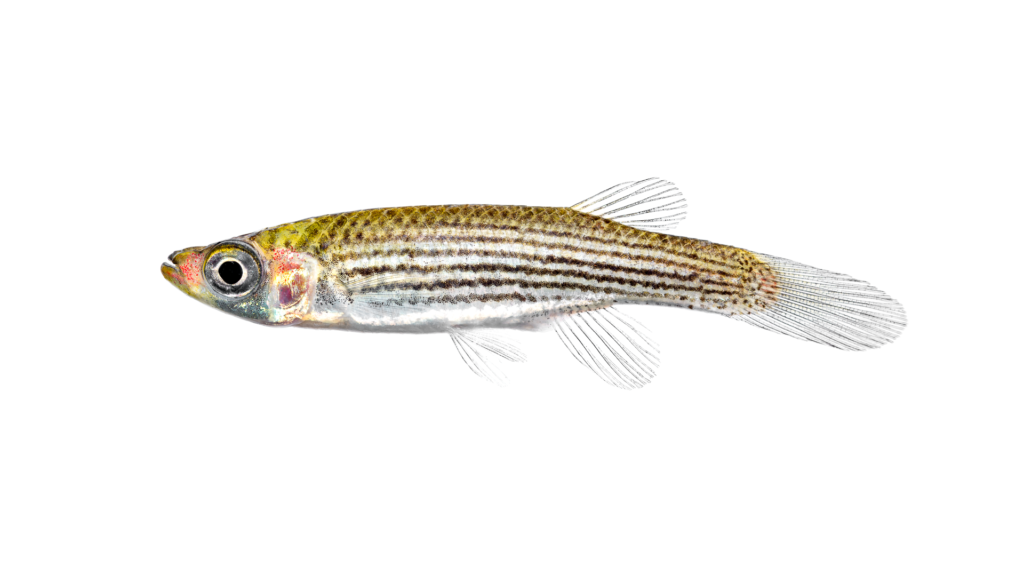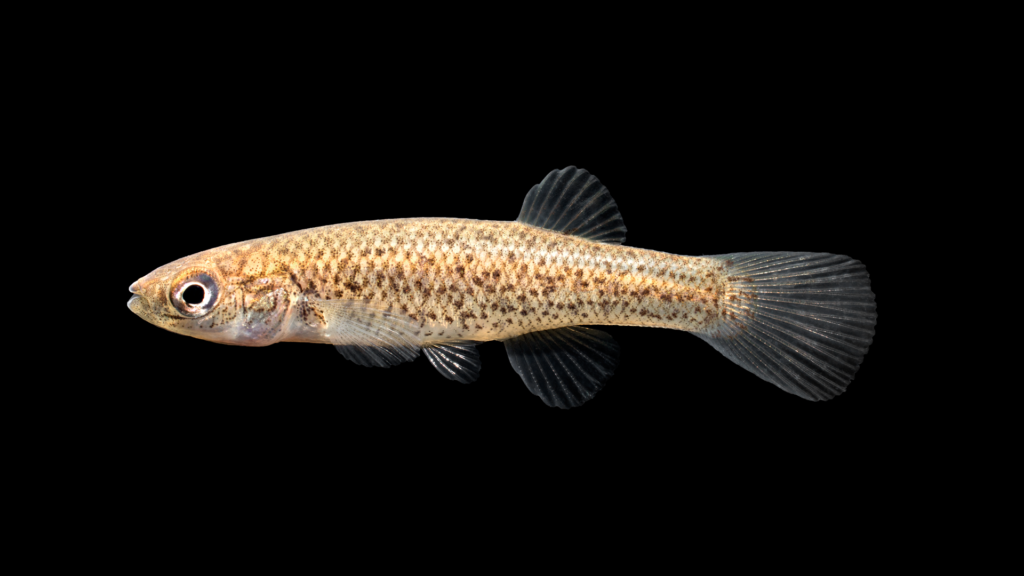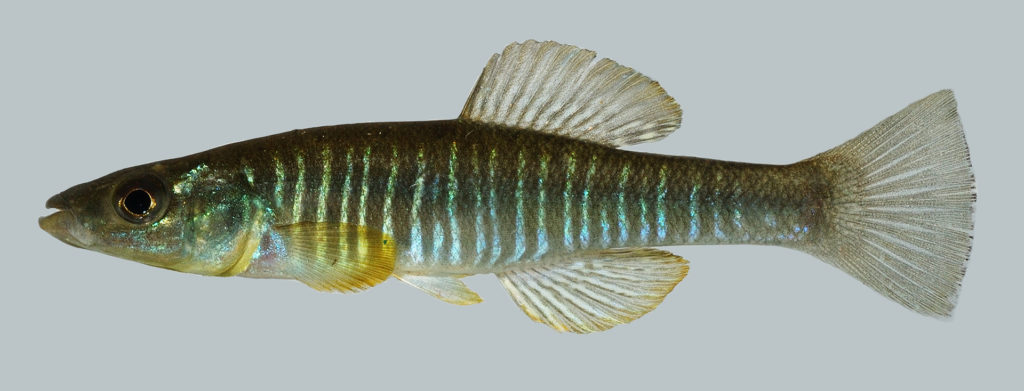By the NCFishes.com Team
The Topminnow Family in North Carolina is a small family of 11 scientifically described and 1 undescribed species (Table 1) occurring primarily within the eastern Coastal Plain and within the estuarine marshes along the Atlantic Coast (Menhinick 1991; Tracy et al. 2020). [Please note: Tracy et al. (2020) may be downloaded for free at: https://trace.tennessee.edu/sfcproceedings/vol1/iss60/1.]
Table 1. Species of topminnows found in North Carolina. Common name enclosed within tick marks (“) is a scientifically undescribed species.| Scientific Name/ American Fisheries Society Accepted Common Name | Scientific Name/ American Fisheries Society Accepted Common Name |
|---|---|
| Golden Topminnow, Fundulus chrysotus | Striped Killifish, Fundulus majalis |
| Marsh Killifish, Fundulus confluentus | Speckled Killifish, Fundulus rathbuni |
| Banded Killifish, Fundulus diaphanus | Waccamaw Killifish, Fundulus waccamensis |
| Mummichog, Fundulus heteroclitus | Fundulus sp. “Lake Phelps” Killifish |
| Lined Topminnow, Fundulus lineolatus | Bluefin Killifish, Lucania goodei |
| Spotfin Killifish, Fundulus luciae | Rainwater Killifish, Lucania parva |
Often referred to as killifishes, top minnows, or mud-minnows, each species has its own scientific (Latin) name which actually means something (please refer to The Meanings of the Scientific Names of Topminnows, page 13) along with an American Fisheries Society-accepted common name (Page et al. 2013).
Topminnows range in size from the diminutive Lucania at 50 mm to the 200 mm Striped Killifish. Because of their abundance and the ease by which they can be collected, they are often sold and used as bait fish along the Coast. As previously stated, most species are found in the eastern part of the state, although one species, Speckled Killifish, is found in the central Piedmont (Maps 1- 12). There are no species in our river basins west of the Appalachian Mountains. [Note: see Supplemental Maps 1-3 , page 14, showing North Carolina’s 100 counties, 21 river basins, and 4 physiographic regions.]
Most of our species inhabit a variety of coastal aquatic environments (Table 2) and have a wide-ranging tolerance to salinities. Speckled Killifish, Waccamaw Killifish, and Fundulus sp. “Lake Phelps” Killifish are known to inhabit only freshwater environments.
The Waccamaw basin is home to two of our three species found in only one river basin – Golden Topminnow and Waccamaw Killifish; the other species, Bluefin Killifish is found only in the Cape Fear basin. The Golden Topminnow is a recent, naturally-occurring migrant from South Carolina; it was unknown to occur in North Carolina until 2007 when it was first discovered in Marlowe Branch in Columbus County. The Bluefin Killifish is our state’s only nonindigenous (non-native or introduced) topminnow. Speckled Killifish is suspected of being introduced in the Catawba basin and questionably Fundulus sp. “Lake Phelps” Killifish or perhaps Banded Killifish has been discovered in Shearon Harris Lake in southern Wake County, Cape Fear basin (Tracy et al. 2020).
The Lined Topminnow is our most widely distributed species being found in 11 basins. The Cape Fear basin contains the most species, seven; whereas the Catawba and Lumber basins each have only one species.
Two species were described for the first time from North Carolina. Waccamaw Killifish described in 1946 from Lake Waccamaw in Columbus County (Hubbs and Raney 1946) and Speckled Killifish described in 1889 from several localities in the Haw River watershed in Guilford County (Jordan 1889).
Table 2. Physiographic regions and habitats in which to find North Carolina’s Killifish. Adapted from Hardy (1980), Lee (1980), Shute et al. 1983, Rohde (2009), and Kells and Carpenter (2011).| Species | Physiographic Region | Habitats |
|---|---|---|
| Golden Topminnow | Southeastern Coastal Plain | Open, sunlit, quiet, slow, shallow, warm, heavily vegetated waters of marshes, swamps, lake shores, sloughs, drainage ditches, borrow pits, and creek waters; also occurring in slightly to moderately saline waters |
| Marsh Killifish | Eastern Coastal Plain | Freshwater rivers and streams and brackish water tidal streams, coastal bays, marshes, channels, and over seagrass flats |
| Banded Killifish | Primarily northeastern Coastal Plain | Calm, slow, and clear water of rivers and creeks, but also occurring from, small inland streams to wide tidal rivers with low salinity, usually over a bottom of open sand |
| Mummichog | Eastern Coastal Plain | Tidal marshes, creeks, and ditches over mud flats and in or near vegetation, but also often occurring in fresh water |
| Lined Topminnow | Sand Hills, Coastal Plain | Freshwater, soft-water, dystrophic, acidic, clear or tannin-stained quiet portions of streams, sloughs, drainage ditches, borrow pits, and ponds, especially near submerged or emergent vegetation |
| Spotfin Killifish | Southeastern Coastal Plain | Estuarine, typically in intertidal salt marshes |
| Striped Killifish | Eastern Coastal Plain | Preferring high salinities in inlets, bays, estuaries, marshes, and also along beaches |
| Speckled Killifish | Central Piedmont | Freshwater, common in pools and runs of streams, usually over mud or sand bottoms |
| Waccamaw Killifish | Coastal Plain – Lake Waccamaw | Freshwater, occurring in large schools in shallow water along the sandy to muddy shoreline, often associated with submerged or emergent vegetation |
| Fundulus sp. “Lake Phelps” Killifish | Coastal Plain – Lake Phelps | Freshwater, occurring in large schools in shallow water along the sandy to muddy shoreline, often associated with submerged or emergent vegetation |
| Bluefin Killifish | Wilmington, New Hanover County | Freshwater, only occurring in the lake and outfall |
| Rainwater Killifish | Eastern Coastal Plain | Saltwater environments, but also occurring in some freshwater habitats; usually associated with dense vegetation |
Because of their limited distributions and anthropogenic impacts upon their habitats, three species are listed as imperiled – Fundulus sp. “Lake Phelps” Killifish, which is Significantly Rare; Waccamaw Killifish which is Special Concern; and Bluefin Killifish which is Special Concern (Krabbenhoft et al. 2009; NCAC 2017; NCNHP 2018; NCWRC 2017).
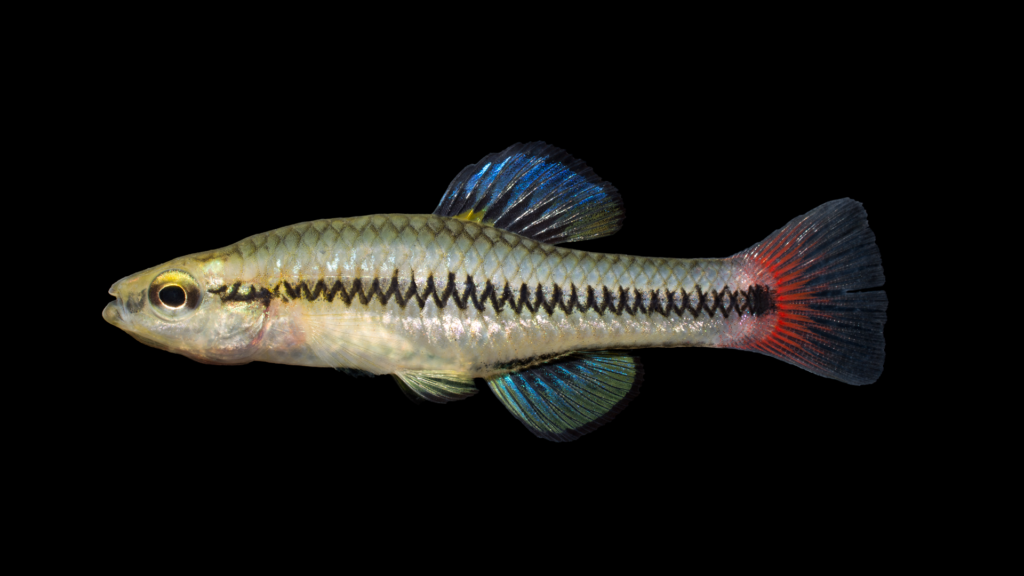
Their identification is relatively straight-forward. Key characteristics for their proper identification include the positioning of the dorsal fin relative to the snout and caudal fin, origin of the dorsal fin relative to the origin of the anal fin; color patterns; number of dorsal fin rays; number of gill rakers, and lateral scale count (please refer to the Identification Key to the Species of Topminnows (Family Fundulidae) in North Carolina). However, several species can co-occur within the same habitats at the same time, rendering field identifications a challenge.
If you have troubles with your identifications, just send us (https://ncfishes.com/contact/) an e-mail and include as many quality digital photographs as you can along with all the pertinent locality descriptors so that we will know from where the fish came.
